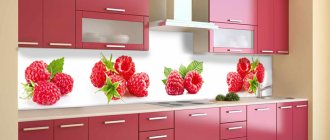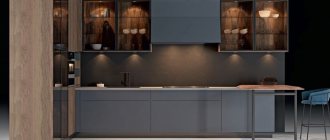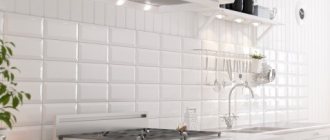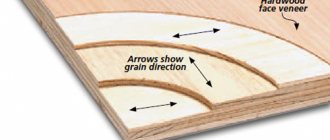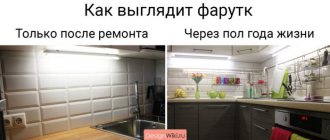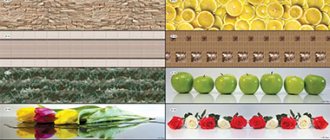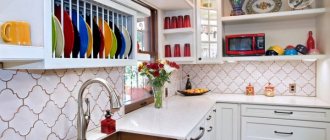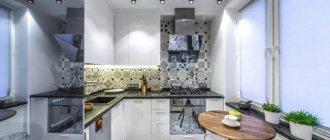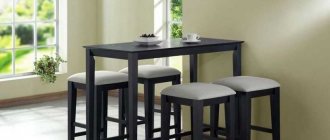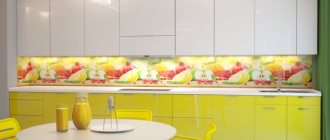<
>
In every kitchen there is a certain section of the wall, located between the cabinets (wall-mounted and floor-mounted) and the stove, sink, work surfaces and various electrical appliances, which needs protection from normal contamination during the cooking process. A kitchen apron is a structure installed in this space to protect the wall. Today, the most popular is a plastic apron for the kitchen, as it is quite practical, durable, easy to clean and can become a real interior decoration.
Types of plastic kitchen aprons
It is known that plastic panels have been used to protect the work wall in the kitchen for many years. Such designs are suitable for decorating surfaces with defects and irregularities. Let's take a closer look at the existing species.
The PVC panel is easily installed on a wooden floor under the headset PHOTO: vplate.ru
Kitchen apron made of PVC panels
A kitchen apron made of PVC can be slatted (resembles clapboard in appearance) or sheet. The dimensions of the latter do not have standards, so it is better to purchase to order. The pattern is applied to the surface of the material using a special technology. The texture of the structure can be glossy or matte. The first option is easier to clean.
ABS plastic kitchen apron
These structures consist of substances such as acrylonitrile, butadiene and styrene. A kitchen apron made of ABS plastic has an excellent independent decor and can have either a glossy or matte surface. When making a drawing, the photo printing method is used.
You can cover a work area of any complexity with panels in the kitchen PHOTO: dekor-td.ru
Externally, the surface can imitate glass. To make it heat-resistant, it is coated with a special varnish in several layers.
Apron made of acrylic glass (polycarbonate)
This is one of the worthy options for decorating a work area in the kitchen. It has long been an alternative to traditional glass surfaces. Using a polycarbonate kitchen apron, you can create the most unusual designs; it is even possible to combine them with each other.
It is advisable to stick transparent polycarbonate directly onto existing wallpaper PHOTO: avglass.ru
From this material, you can choose a plain panel or order a surface with a specific pattern using photo printing technology. You can even use an enlarged format of a family photo for this purpose.
Related article:
The best option for decorating the cooking area are kitchen aprons - skinali , photos of which are presented in our review. Read on to learn why they have become so popular.
How much does it cost and where to buy
You can purchase plastic panels for the apron in an online store or large construction hypermarkets. Currently, almost any retailer offers a wide range of similar products.
Before purchasing, you should carefully read the documentation and ask the seller for safety certificates. The fact is that low-quality plastic produced in artisanal conditions can release chemicals hazardous to health into the air.
The average cost of plastic for an apron is:
PVC - from RUB 160.00/sq.m.
ABS - from RUB 800.00/sq.m.
Acrylic glass (polycarbonate) - from RUB 5,000.00 / sq. m.
The final price is influenced by the type of source material, thickness, individual design and method of applying the design.
Advantages and disadvantages of plastic panels for kitchen aprons
Such raw materials for kitchen aprons are considered to be in greatest demand. It deserves its popularity due to a number of advantages. However, the panels are not without their drawbacks. More details about them in this section. It is advisable to consider the available qualities for each type of artificial work area.
The right choice of design always evokes a feeling of appetite PHOTO: pere-stroika.ru
PVC
The most budget-friendly, but also one of the worst in quality. As for the advantages:
- low price;
- basic care;
- easy DIY installation.
A good option for a kitchen in marble style PHOTO: steni-pol.ru
Disadvantages of this material:
- fades quickly and is easily damaged;
- has been in use for no more than one year;
- requires constant cleaning of grease drops during cooking;
- melts easily.
Kitchen apron panels made of plastic can be installed either on a small area of the work area or used for protection around the perimeter of the premises. Sometimes such panels are used to decorate corners if there are electrical appliances nearby.
ABS
Higher quality removable work wall. Has a large number of advantages:
- light weight;
- environmental friendliness;
- wide range of textures.
Reflects strongly in improperly organized lighting PHOTO: vplate.ru
The disadvantages of raw materials include:
- burns out quickly;
- unstable to household chemicals;
- does not withstand treatment with the hard side of the sponge;
- Custom drawing requires additional investment.
Many people are not happy that ABS has a slight yellow tint. From the outside it does not look aesthetically pleasing; one might suspect the old age of the material.
Acrylic
This model is considered one of the best among all plastic ones. Has the following advantages:
- durable paint that does not fade;
- transparent, practically no different from glass;
- heat-resistant, can be used near a gas stove;
- withstands mechanical damage.
Stylish design that matches the tone of the headset PHOTO: sta-74.ru
Regarding the disadvantages, we can only name too high a cost. However, this design will last for many years.
Related article:
Glass kitchen apron. Catalog, photos, advantages, varieties, selection criteria, model range, secrets of do-it-yourself installation, advice and recommendations from experts - you will find in the material on our portal.
Materials and calculation rules
To finish the apron, experts use a wide variety of materials. Possible options include:
- ceramic tiles or mosaics;
- MDF;
- glass panels, mirror elements that are protected from steam and fire;
- polymer materials, PVC;
- brick or stone;
- metal.
Any of the materials described has advantages and disadvantages, its own characteristics, but they all make it possible to protect kitchen walls. They are easy to care for, clean from dirt, and you can create an unusual design. The choice of finish depends on the personal preferences of the owners, but the dimensions must be clearly calculated.
It is very difficult to say specifically which standard to choose for an apron, since for calculations it is important to understand and know the parameters of all the furniture and other features. To begin with, the design of the kitchen space is carried out, the height of the tables, the level of wall-mounted furniture are measured, the kitchen set is selected, and its location in the kitchen.
To correctly calculate the height from the floor to the apron, you need to take into account the distance from the floor to the floor cabinets.
To do this, it is important to consider the rules:
- choose tables according to the height and other parameters of the owner or all family members who will sit at it;
- the height of the slab is taken into account;
- additional equipment is taken into account, whether it will be built into the furniture;
- To simplify the process, it’s easier to buy a ready-made headset made according to standard parameters.
Let's look at the standard and optimal values for an apron.
Beautiful aprons for the kitchen made of plastic - photos of options from catalogs
Whether it is a decorative part of the kitchen or a functional protective screen, you should choose the design design wisely. We bring to your attention several photo options for the most popular interior styles.
Hi-tech, techno and minimalism
Depending on the style of the interior, you should also choose plastic panels to protect the work area.
A light panel that harmonizes well with dark furniture PHOTO: kuchnieformat.pl
Stylish model with plain geometry around the entire perimeter PHOTO: mydizajn.ru
Classic light surface for small kitchens PHOTO: kuhni-iz-spb.ru
Kitchen interior design in techno style is always carried out in decorative details. This also applies to protective screens. For this trend, they try to use colorful aprons that accentuate attention.
A multi-color model depicting a residential area and high-rise buildings will visually increase the space of the room PHOTO: fartuki.com-world.ru
This option will not be superfluous in kitchens with a one-sided set PHOTO: rsk-nsk.ru
Panel depicting a city at night with a body of water in the foreground. An excellent option for a kitchen with red or burgundy furniture PHOTO: fartuki.com-world.ru
The minimalist interior style is always limited in terms of decor. The following photos of plastic kitchen aprons prove this in practice.
A plain surface for the kitchen without patterns or obtrusive decors PHOTO: vseme.ru
An option with a mirror reflection, the panel is made in coffee color, diluting the light motif of the room PHOTO: housesdesign.ru
A spectacular, rich dark style emphasizes the overall atmosphere of the kitchen PHOTO: drmebel.ru
Futurism and Art Nouveau
Futurism is a very unusual and rarely seen trend in kitchen design. As for the protective surfaces for the work area, they stand out effectively against the general background of the room.
Bright shade of the panel with sea waves. Looks good when decorating one working wall PHOTO: vplate.ru
An equally interesting option for decorating a kitchen apron PHOTO: plitech.ru
Care
Despite the unpretentiousness of plastic aprons, it is necessary to ensure proper care for them:
- Regularly clean the surface from dirt using a damp sponge. Particular attention is paid to grease stains, which are well absorbed by many polymers, and after drying they are extremely difficult to remove.
- Do not use highly aggressive products, such as acetone. Dish cleaning products are best.
- It must be remembered that abrasive substances can damage the surface of the plastic. The resulting scratches will be especially noticeable on a glossy surface.
- The fire of the stove burners can cause the plastic to ignite or heat it to an unacceptable temperature, where there is a risk of harmful emissions. It is advisable to use special thermal screens in the slab area.
- For most plastics, direct sunlight is harmful. The pattern and color quickly fade. Care should be taken to avoid such influences.
- Special care requirements are provided in the instructions for use of the materials. If they are not included with the product, then you need to analyze the features of the plastic according to information on the Internet.
Plastic aprons have gained wide popularity in modern kitchen interiors. This is facilitated by their high quality, unpretentiousness, ease of installation and great design possibilities. Such elements effectively compete with ceramic tiles, glass and other expensive coatings.
How to choose a plastic apron
First of all, when choosing panels for a backsplash in the kitchen, you should pay attention to models that will match the frame, style and shades. Contrasts and inadequate palette combinations are also acceptable.
- Too colorful, pretentious tones are not always appropriate. Professionals believe that they negatively affect the functioning of the gastrointestinal tract.
- If the overall decor of the kitchen has a restrained design, the design of the apron should accordingly be several times brighter.
- It is possible to design the apron to match the tabletop, this is especially true for a set that imitates natural wood.
- If there is lighting in the work area, then it is better to give preference to polycarbonate apron models.
- Don't forget about creating optical illusions. To do this, choose panels with horizontal lines to extend the width.
- A very dark apron is allowed in isolated cases. On such models, dirt accumulates quickly and unnoticed. Removing them is problematic.
Model with excellent imitation of designer wallpaper PHOTO: dekoriko.ru
Also, when choosing, you should pay attention to the size of the plastic apron for the kitchen. It should extend a few centimeters behind the furniture set.
Design ideas
In order for such a finish to look stylish and not cheapen the interior, it is better to pay attention to options with natural wood finishes: wood, marble, stone, brick. A light sheet with marble “veins” looks especially relevant. The main thing is to choose textures and images that are as close to natural as possible. In one version, imitation wood can look very natural, but in another it can look completely unnatural. The colors should not be too bright, and the top layer should not be glossy. Matte surfaces look better because glare and reflections will give off unnaturalness. As for texture, there are options for panels with a rough finish. In this design, the imitation of rocks looks quite natural.
Instagram @schmidt_officiel
Instagram @rkply01
ShutterStock
You should also give preference to monochromatic options or simple geometry, imitation tiles, bricks. It is better to choose sheets that cover the entire length of the working surface, so that there are no unnecessary joints (it is simply impossible to glue sheets so that the seams are not visible, but it looks ugly, besides, moisture will get into the joints, and the coating will quickly become unusable) . For this reason, it is worth abandoning PVC tiles, which are glued to the wall like ordinary ceramic ones.
Instagram @tepian.living
Instagram @riko.ua
Instagram @demiliodesign
Instagram @_magnoliahome
Polycarbonate cladding can be used in different ways, by gluing it on top of wallpaper, a painted wall, or masonry made of natural stone or wood. The glossy glass finish looks good in minimalist and modern kitchens.
ShutterStock
ShutterStock
Instagram @rkply01
- Kitchen
How to decorate the walls in the kitchen: 11 materials and examples of their use
How to attach a foam apron in the kitchen
There are several methods that are used to secure the kitchen screen. Each of them has its own characteristics and convenience.
How to attach a kitchen apron made of plastic on guides
They try to install the budget plastic version of the panels on guides. This is convenient because after the structure is out of service, it can be easily replaced with a new one. For this purpose, special fittings are used, which are mounted at the required height from wall and floor furniture. Fixed with self-tapping screws.
Fasteners are made of metal alloy PHOTO: vplate.ru
Next, all that remains is to insert the panels one after another, leaving a minimum of gaps between the joints.
How to attach a plastic apron in the kitchen using self-tapping screws
If guide clamps take up useful space, many resort to using self-tapping screws during the installation process. For this, the walls are pre-prepared. They must be perfectly even.
You can simultaneously use two methods of capturing PHOTO: vialonmebel.ru
The plastic itself is drilled. To prevent it from deforming, holes are first made in the attachment points and special rivets are inserted. The screws themselves can be hidden under the headset or using special plugs to match the panels.
How to attach a plastic kitchen apron to the sheathing
Lathing is considered the most reliable way to best secure a plastic apron in the kitchen. It also involves the use of self-tapping screws. In case a plastic sheathing is used, the guides must be left free.
Special metal brackets are used for lathing PHOTO: gorbel.ru
The niches formed under the plastic panel are convenient for running wiring. However, knives and other sharp objects should be used carefully in this area. There is a risk of deeply piercing the structure. Therefore, this option for attaching a plastic apron for the kitchen is not always practical.
How to glue an apron to a plastic kitchen
Many owners personally install PVC kitchen panels using a special adhesive. This method of solving the question of how to glue a plastic apron in the kitchen is considered simple, quick and understandable. In addition to special glue, you can use liquid nails. They adhere the plastic to the concrete wall much more reliably.
Glue must be applied around the entire perimeter of the plastic screen PHOTO: dom-i-remont.info
Before gluing artificial plastic, holes for electrical appliances are pre-cut PHOTO: rsk-nsk.ru
Which drawing to choose
The panel can look like ceramic tiles for spacious and small kitchens, and have a similar texture. Modern materials make it possible to create an imitation of decorative stone from plastic elements, brick or mosaic. This coating looks expensive, stylish and affordable, see example in the photo.
Stone imitation
Some manufacturing companies offer to apply a custom design to the panel, at the client’s request. You can choose a family photo or a favorite painting.
Family photos
One of the most popular prints for kitchen decoration is flora and fauna. Photos with plants, grass, lavender, wheat fields, funny animals and insects are transferred to plastic panels.
Flowers
Thematic canvases with food products are not left out. Macro photos of coffee, cakes, berries, fruits and vegetables are used to decorate plastic. Such compositions correspond to the theme of the cuisine and create an appetizing mood.
Spices and coffee
Three-dimensional images create the effect of visually increasing space; for this they use landscapes and natural themes. A correctly selected pattern on aprons helps to zone a room and focus attention on a wall or one section of it.
Expansion of space
The color of the plastic apron can match the decoration of the room or the details of the furniture set. Often the shades have something in common with the fronts of MDF drawers, the handles on them, and the covering of walls or floors.
Apron to match the color of the facades
Most often, photo printing is applied to kitchen aprons made of plastic; neutral designs that do not attract attention are popular. Therefore, a panel matching the color of the countertop or with a similar design will be an excellent solution.
Under the countertop
Often, the apron visually becomes a continuation of the walls, repeating the color of the finish or the pattern on the photo print.
Match the color of the walls
Effect of materials
Most often, aprons are made of tiles, but depending on the material, the height of the working area may vary. For example, decorative glass panels are made to order, so it is possible to adjust the dimensions to the standard.
MDF boards can also be adjusted. They are simply cut into the required parts, the ends are sealed with tape or veneer.
It is difficult to adjust the tile to size; trimming it will look very unsightly in the kitchen. Kitchen tiles are produced in square shape with dimensions 10x10, 20x20, 30x30. Such options are easy to adjust to aprons of 60, 80 cm. But if the height turns out to be 50 cm, then there may be certain difficulties.
Ceramic and porcelain tiles
Facing is the most common, time-tested and tested by many people.
Advantages of a ceramic tile apron:
- high levels of thermal and moisture resistance;
- not exposed to aggressive substances in the form of detergents;
- durability;
- wear resistance and strength;
- large selection of sizes, colors and textures;
- just clears.
The main disadvantages of the material are considered to be complex installation, and for high-quality work you will need to hire professionals who are paid dearly. Installation turns out to be quite lengthy, and some additional materials, in the form of grout, turn out to be very expensive.
MDF
The simplest type of cladding for the kitchen, especially if a major renovation is being carried out. Experts advise choosing this type of apron together with the tabletop and furniture.
The main advantages of the material:
- the ability to choose any color, a huge number of color solutions;
- easy and quick installation, just use special staples or glue;
- strength, impact resistance;
- there is no need to pre-level the walls;
- after installation there are no joints;
- Maintenance and cleaning are easy; if desired or necessary, the element can be dismantled and changed.
Among the main disadvantages is a short service life in comparison with other finishing materials. The boards themselves are subject to combustion, and when moisture gets under the film, the product swells.
We wrote in detail about the MDF material in this article >>>
